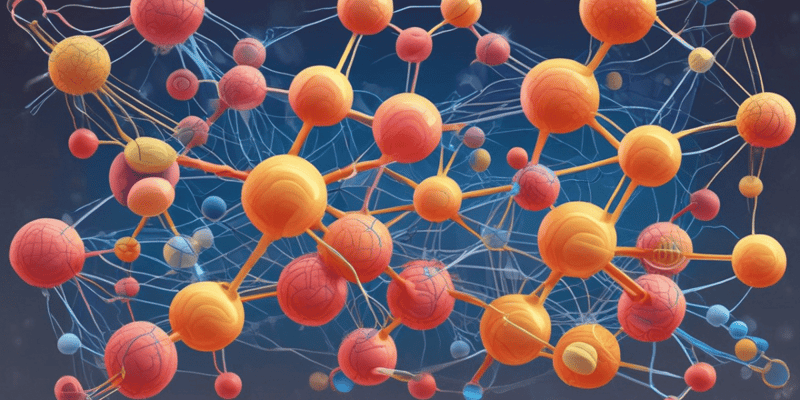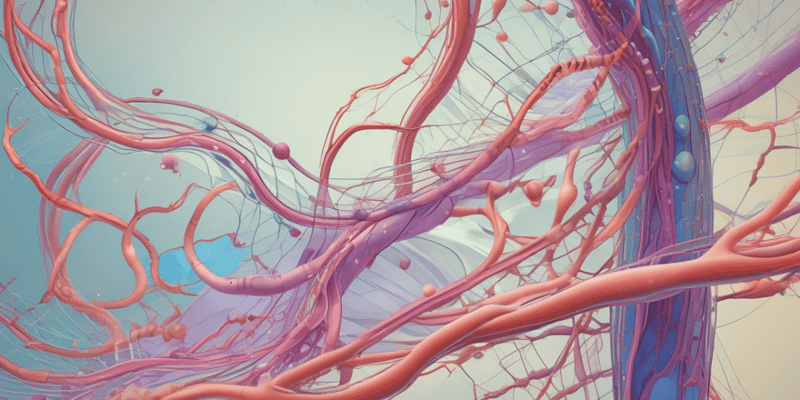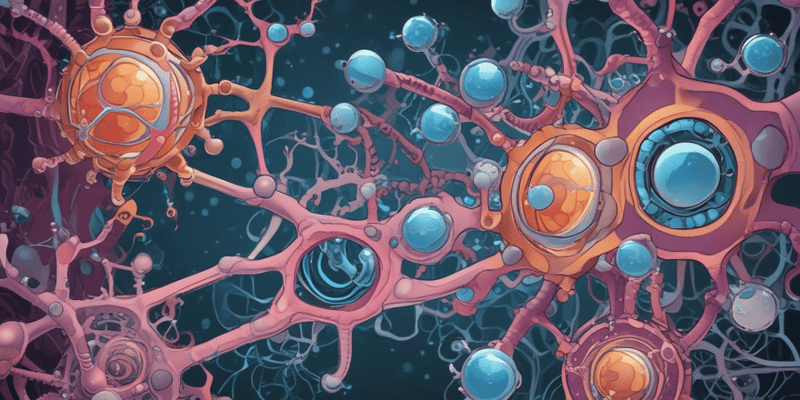45 Questions
Which cellular pathway involves the sequential addition of ubiquitin chains to target proteins?
Ubiquitin-Proteasome System (UPS)
Which mechanism is an ATP-dependent, non-lysosomal protein degradation system in cells?
Ubiquitin-Proteasome System (UPS)
Which process is primarily responsible for the degradation of damaged organelles like mitochondria and peroxisomes?
Selective autophagy
Which pathway is involved in the degradation of short-lived proteins and misfolded soluble proteins?
Ubiquitin-Proteasome System (UPS)
Which protein degradation system is responsible for recycling amino acids for energy production?
Proteasome
Which type of autophagy involves the direct engulfment of cytoplasmic material at the lysosomal membrane?
Microautophagy
What role do proteases play in the UPS?
Break down proteins into smaller peptides or amino acids
How are autophagy and the UPS interconnected?
Through recognition of targets by ubiquitin tags
Which E3 ligase is responsible for the degradation of AMBRA1 under nutrient-rich conditions?
Cullin-4
What is the function of deubiquitinating enzymes (DUBs) in cells?
Remove ubiquitin from substrates
How does the E3 ligase NEDD4 influence Beclin1?
Mediates K11-linked ubiquitylation leading to degradation
Which proteins involved in autophagy are regulated by the UPS?
PI3K complex subunit p85b
Which cellular process involves the hydrolysis of peptide bonds in proteins?
Proteases
What is the function of deubiquitinating enzymes (DUBs) in the ubiquitination pathway?
Remove ubiquitin from proteins
How do proteasomes recognize proteins targeted for degradation?
By detecting polyubiquitin chains
Which complex plays a central role in the Ubiquitin-Proteasome System (UPS)?
Proteasome
What is the role of HDAC6 in the crosstalk between UPS and autophagy?
Link UPS and autophagy by interacting with polyubiquitinated proteins
During cellular stress, what process is activated to promote transcription of p62?
Unfolded protein response (UPR)
What is the primary function of the ubiquitin-proteasome system (UPS) in protein degradation?
Recognition and degradation of polyubiquitylated proteins
Which cellular process involves the degradation of short-lived proteins and soluble misfolded proteins?
Ubiquitin-proteasome system (UPS)
What is the main function of autophagy in protein degradation?
Targeting insoluble protein aggregates and organelles for degradation
Which process involves the formation of phagophores that engulf target proteins before fusion with lysosomes?
Autophagy
What distinguishes the proteins targeted for degradation by autophagy from those targeted by the UPS?
Size of the protein aggregates
Which cellular process involves the sequential addition of ubiquitin chains to target proteins for recognition and degradation?
Ubiquitin-proteasome system (UPS)
How do autophagy and the UPS interact with each other in terms of protein degradation?
Autophagy and the UPS interact through ubiquitylated proteins and regulatory mechanisms.
What is the effect of inhibiting the proteasome on autophagy?
The inhibition of the proteasome can stimulate autophagy.
How does overabundant p62 affect the transport of substrates to proteasomes?
Overabundant p62 can delay the transport of substrates to proteasomes.
What role does HDAC6 play in the crosstalk between UPS and autophagy?
HDAC6 inhibition can enhance the cytotoxicity of proteasome inhibitors.
Which enzyme catalyzes the cleavage of peptide bonds in proteins for degradation?
Proteases catalyze the cleavage of peptide bonds in proteins.
How do proteasomes process LC3 protein during autophagy?
Proteasomes can process LC3 protein in a stepwise manner.
What is the effect of inhibiting autophagy on proteasomal flux?
The inhibition of autophagy can impair proteasomal flux.
What is the primary target of autophagy in terms of protein degradation?
Autophagy primarily targets insoluble protein aggregates and whole organelles.
How does E3 ligase NEDD4 influence Beclin1 in the context of autophagy?
NEDD4-mediated K11-linked ubiquitylation of Beclin1 can prevent its binding to VPS34.
What is the significance of ubiquitin tags in the protein degradation pathways?
Ubiquitin tags are crucial for targeting proteins for degradation via autophagy and the UPS.
Explain the role of the ubiquitin-proteasome system (UPS) in degrading proteins. How are proteins targeted for degradation by the UPS?
The UPS degrades soluble, short-lived proteins, misfolded, or damaged proteins by adding ubiquitin molecules to them, forming a polyubiquitin chain. Proteins are targeted for degradation by the UPS through ubiquitination.
What is the process by which proteasomes recognize and degrade ubiquitinated proteins? Explain the role of proteases in this process.
Proteasomes recognize and degrade ubiquitinated proteins by breaking down the polyubiquitin chain and unfolding the protein for degradation. Proteases within the proteasome then cleave the protein into small peptides.
Describe the mechanism of protein degradation through autophagy. How does autophagy differ from the ubiquitin-proteasome system (UPS) in terms of substrate specificity?
Autophagy involves the formation of phagophores that engulf target proteins, leading to fusion with lysosomes for degradation. Autophagy targets larger protein aggregates and damaged organelles, while the UPS targets soluble, short-lived proteins.
Explain the crosstalk between the ubiquitin-proteasome system (UPS) and autophagy. How do these two pathways complement each other in protein degradation?
The UPS and autophagy pathways are interconnected through regulatory proteins like HDAC6, enabling the clearance of different types of protein substrates. The UPS degrades soluble proteins, while autophagy targets larger aggregates and damaged organelles.
What is the primary function of proteases in the ubiquitin-proteasome system (UPS)? How do proteases contribute to protein degradation within the proteasome?
Proteases within the proteasome cleave ubiquitinated proteins into smaller peptides during degradation. They are responsible for breaking down proteins into manageable fragments for recycling.
Discuss the importance of protein degradation pathways in maintaining cellular homeostasis. How do the UPS and autophagy contribute to preventing cellular dysfunction?
Protein degradation pathways like the UPS and autophagy eliminate damaged proteins, preventing their accumulation and potential cellular dysfunction. They ensure proper cellular function and maintain protein quality control.
What is the primary purpose of pulse-chase experiments in radiobiology?
Determining the toxicity of radiation to cells
In psychology, what did a study by Träuble et al. using pulse-chase experiments find about subjects' gaze behavior?
Subjects pursue moving objects as a single group by alternating gaze
How do pulse-chase experiments help in understanding protein degradation within cells in radiobiology?
By studying the effects of radiation on cellular organelles
What is the main focus of pulse-chase experiments in computer science and artificial intelligence?
Tracing the fate of signals in neural networks
How do pulse-chase experiments contribute to research in computer science and AI?
By tracing the fate of signals in neural networks
Study Notes
Protein Biology: Ubiquitination, Proteasome, Proteases, Autophagy, and Protein Degradation
Protein biology is a crucial field that involves the study of proteins, their functions, and their regulation within cells. Two major pathways are responsible for the degradation of cellular proteins in eukaryotic cells: the ubiquitin-proteasome system (UPS) and autophagy. These pathways work together to maintain cellular homeostasis, degrade damaged or misfolded proteins, and recycle amino acids for energy production.
Ubiquitin-Proteasome System (UPS)
The UPS is an ATP-dependent, non-lysosomal protein degradation mechanism in cells. It involves the sequential addition of ubiquitin chains to target proteins, followed by recognition and degradation by proteasomes. The UPS is responsible for the degradation of short-lived proteins, soluble misfolded proteins, and other regulated proteins, such as those involved in signal transduction.
Autophagy
Autophagy is a process by which cells recycle their own cellular components, primarily long-lived proteins and aggregated proteins, to maintain cellular homeostasis. It is also responsible for the degradation of damaged organelles, such as mitochondria and peroxisomes, and intracellular parasites. Autophagy has three main types: macroautophagy, microautophagy, and selective autophagy.
Ubiquitin-Proteasome System and Autophagy: Crosstalk and Coordination
Both the UPS and autophagy recognize their targets through ubiquitin tags, and there is evidence of direct and indirect interactions between these degradation pathways. For example, the E3 ligase NEDD4-mediated K11-linked ubiquitylation of Beclin1 leads to its degradation, while p62 binding inhibits the processing of LC3 protein by the proteasome. Additionally, the E3 ligase Cullin-4 is responsible for the ubiquitylation of AMBRA1, leading to its degradation under nutrient-rich conditions where autophagy should be inhibited.
Proteases and UPS-Mediated Degradation
Proteases are enzymes that break down proteins into smaller peptides or individual amino acids. In the context of the UPS, proteases like the 20S proteasome play a crucial role in the degradation of ubiquitinated proteins. Proteasomes are highly efficient organelles that degrade short-lived proteins and soluble misfolded proteins, contributing to the cell's overall protein quality control.
Autophagy Components Regulated by the UPS
Several proteins involved in autophagy are regulated by the UPS, allowing for the control of autophagy activity. For example, the PI3K complex subunit p85b is degraded by the UPS, leading to a decrease in autophagy.
Deubiquitinating Enzymes (DUBs)
DUBs are proteases that remove ubiquitin or ubiquitin-like molecules from substrates, playing an important role in the control of available free ubiquitin pool in cells. They also regulate UPS-mediated degradation in different cellular contexts and are responsible for processing newly synthesized ubiquitin precursors.
In conclusion, protein biology is a complex field that involves the study of various processes, including protein degradation,ubiquitination pathway, proteasome, proteases, and autophagy. These pathways work together to maintain cellular homeostasis, degrade damaged or misfolded proteins, recycle amino acids for energy production, and support development and stress responses.
Test your knowledge on protein degradation pathways in eukaryotic cells, including the ubiquitin-proteasome system (UPS), autophagy, proteases, and the interplay between these mechanisms. Explore the roles of ubiquitination, proteasomes, deubiquitinating enzymes, and autophagy components in maintaining cellular homeostasis and protein quality control.
Make Your Own Quizzes and Flashcards
Convert your notes into interactive study material.
Get started for free


